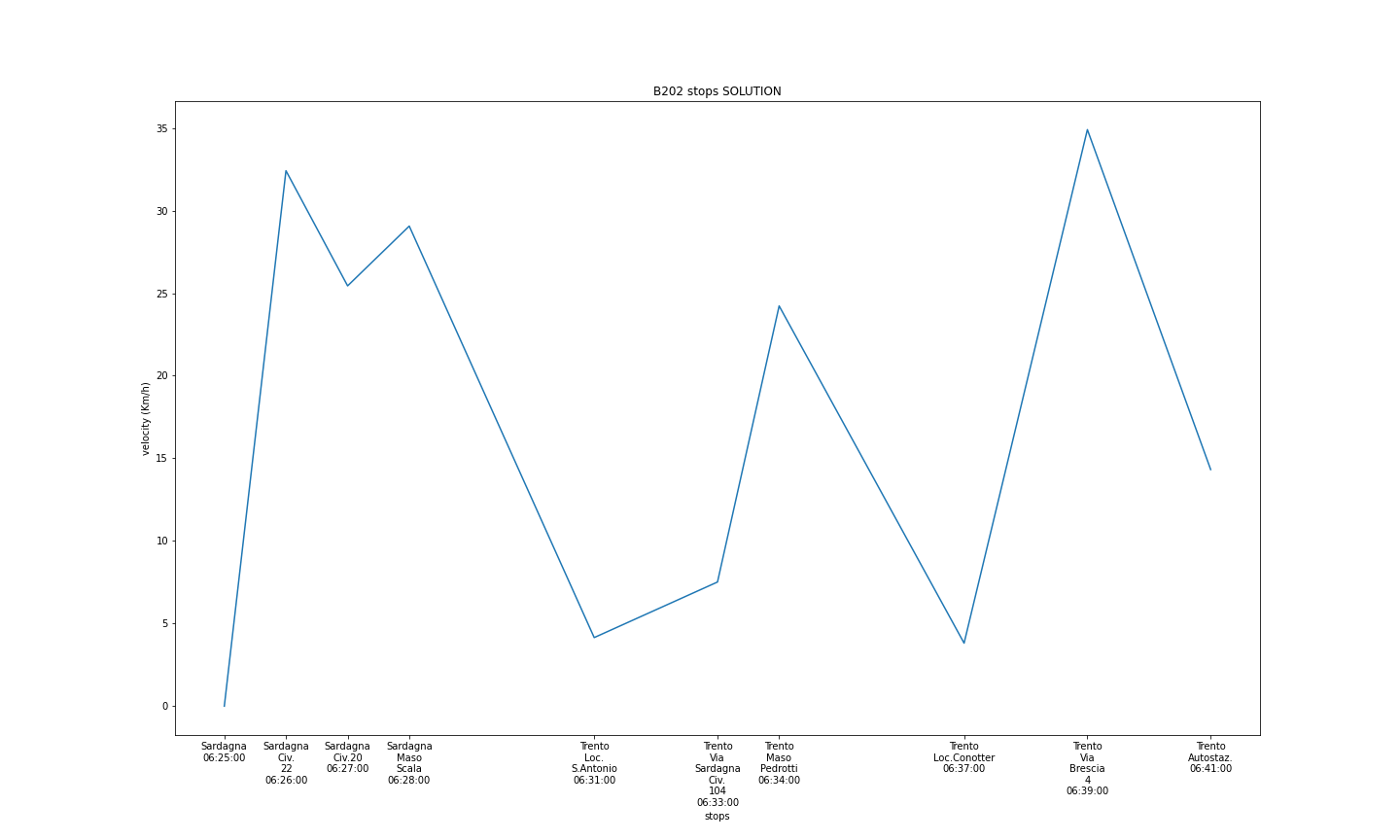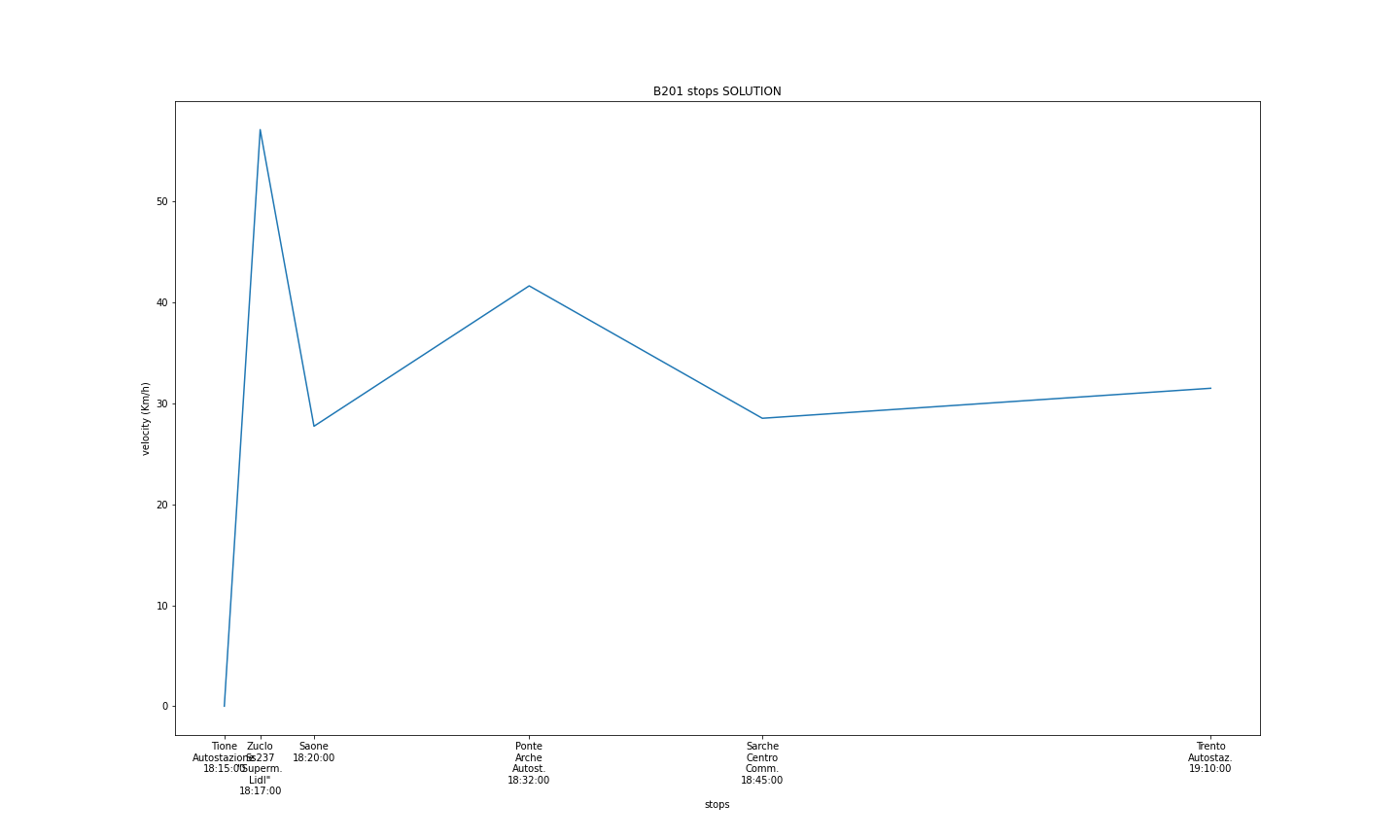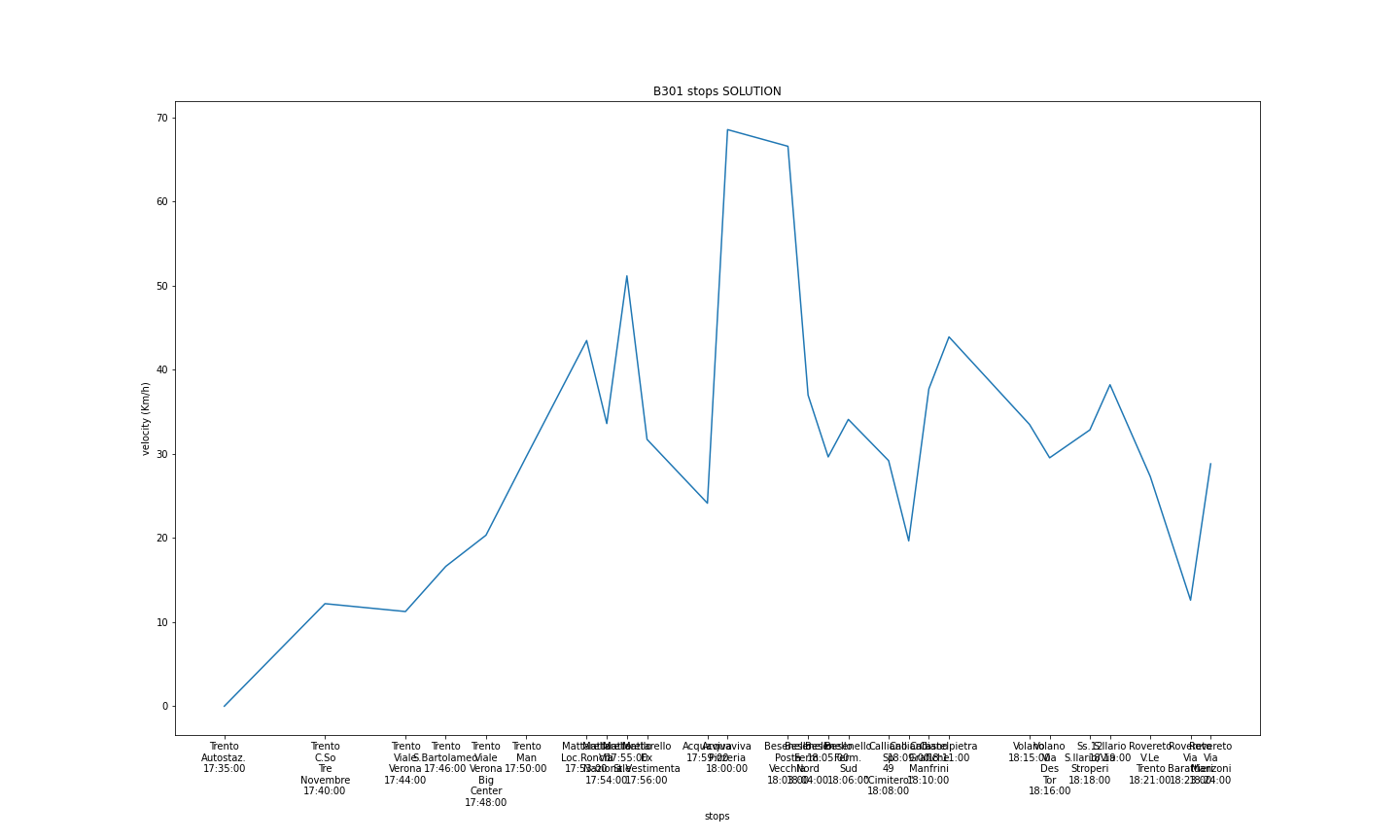Bus speed
Download worked project
In this little project, we will analyze intercity bus velocities in GTFS format.
Data source: dati.trentino.it, MITT service, released under Creative Commons Attribution 4.0 licence.
What to do
Unzip exercises zip in a folder, you should obtain something like this:
bus-speed-prj
bus-speed.ipynb
bus-speed-sol.ipynb
network.csv
jupman.py
WARNING: to correctly visualize the notebook, it MUST be in an unzipped folder !
open Jupyter Notebook from that folder. Two things should open, first a console and then a browser. The browser should show a file list: navigate the list and open the notebook
bus-speed.ipynbGo on reading the notebook, and write in the appropriate cells when asked
Shortcut keys:
to execute Python code inside a Jupyter cell, press
Control + Enterto execute Python code inside a Jupyter cell AND select next cell, press
Shift + Enterto execute Python code inside a Jupyter cell AND a create a new cell aftwerwards, press
Alt + EnterIf the notebooks look stuck, try to select
Kernel -> Restart
The dataset
Original GTFS data was split in several files which we merged into dataset network.csv containing the bus stop times of three extra-urban routes. To load it, we provide this function:
[1]:
def load_stops():
"Loads file network.csv and RETURN a list of dictionaries with the stop times"
import csv
with open('network.csv', newline='', encoding='UTF-8') as csvfile:
reader = csv.DictReader(csvfile)
lst = []
for d in reader:
lst.append(d)
return lst
[2]:
stops = load_stops()
stops[0:2]
[2]:
[OrderedDict([('', '1'),
('route_id', '76'),
('agency_id', '12'),
('route_short_name', 'B202'),
('route_long_name',
'Trento-Sardagna-Candriai-Vaneze-Vason-Viote'),
('route_type', '3'),
('service_id', '22018091220190621'),
('trip_id', '0002402742018091220190621'),
('trip_headsign', 'Trento-Autostaz.'),
('direction_id', '0'),
('arrival_time', '06:25:00'),
('departure_time', '06:25:00'),
('stop_id', '844'),
('stop_sequence', '2'),
('stop_code', '2620'),
('stop_name', 'Sardagna'),
('stop_desc', ''),
('stop_lat', '46.064848'),
('stop_lon', '11.09729'),
('zone_id', '2620.0')]),
OrderedDict([('', '2'),
('route_id', '76'),
('agency_id', '12'),
('route_short_name', 'B202'),
('route_long_name',
'Trento-Sardagna-Candriai-Vaneze-Vason-Viote'),
('route_type', '3'),
('service_id', '22018091220190621'),
('trip_id', '0002402742018091220190621'),
('trip_headsign', 'Trento-Autostaz.'),
('direction_id', '0'),
('arrival_time', '06:26:00'),
('departure_time', '06:26:00'),
('stop_id', '5203'),
('stop_sequence', '3'),
('stop_code', '2620VD'),
('stop_name', 'Sardagna Civ. 22'),
('stop_desc', ''),
('stop_lat', '46.069494'),
('stop_lon', '11.095252'),
('zone_id', '2620.0')])]
Of interest to you are the fields route_short_name, arrival_time, and stop_lat and stop_lon which provide the geographical coordinates of the stop. Stops are already sorted in the file from earliest to latest.
Given a route_short_name, like B202, we want to plot the graph of bus velocity measured in km/hours at each stop. We define velocity at stop n as
\(velocity_n = \frac{\Delta space_n}{\Delta time_n }\)
where
\(\Delta time_n = time_n - time_{n-1}\) as the time in hours the bus takes between stop \(n\) and stop \(n-1\).
and
\(\Delta space_n = space_n - space_{n-1}\) is the distance the bus has moved between stop \(n\) and stop \(n-1\).
We also set \(velocity_0 = 0\)
NOTE FOR TIME: When we say time in hours, it means that if you have the time as string 08:27:42, its number in seconds since midnight is like:
[3]:
secs = 8*60*60+27*60+42
and to calculate the time in float hours you need to divide secs by 60*60=3600:
[4]:
hours_float = secs / (60*60)
hours_float
[4]:
8.461666666666666
NOTE FOR SPACE: Unfortunately, we could not find the actual distance as road length done by the bus between one stop and the next one. So, for the sake of the exercise, we will take the geo distance, that is, we will calculate it using the line distance between the points of the stops, using their geographical coordinates. The function to calculate the geo_distance is already implemented :
[5]:
def geo_distance(lat1, lon1, lat2, lon2):
""" Return the geo distance in kilometers
between the points 1 and 2 at provided geographical coordinates.
"""
# Shamelessly copied from https://stackoverflow.com/a/19412565
from math import sin, cos, sqrt, atan2, radians
# approximate radius of earth in km
R = 6373.0
lat1 = radians(lat1)
lon1 = radians(lon1)
lat2 = radians(lat2)
lon2 = radians(lon2)
dlon = lon2 - lon1
dlat = lat2 - lat1
a = sin(dlat / 2)**2 + cos(lat1) * cos(lat2) * sin(dlon / 2)**2
c = 2 * atan2(sqrt(a), sqrt(1 - a))
return R * c
In the following we see the bus line B102, going from Sardagna to Trento. The graph should show something like the following.
We can see that as long as the bus is taking stops within Sardagna town, velocity (always intended as air-line velocity ) is high, but when the bus has to go to Trento, since there are many twists and turns on the road, it takes a while to arrive even if in geo-distance Trento is near, so actual velocity decreases. In such case it would be much more convenient to take the cable car.
These type of graphs might show places in the territory where shortcuts such as cable cars, tunnels or bridges might be helpful for transportation.
to_float_hour
Implement a function to_float_hour that takes a time string in the format like 08:27:42 and RETURN the time since midnight in hours as a float (es 8.461666666666666)
[6]:
def to_float_hour(time_string):
raise Exception('TODO IMPLEMENT ME !')
plot
Implement a function plot which takes a route_short_name and displays with matplotlib a graph of the velocity of the the bus trip for that route
just use matplotlib, you don’t need pandas and don’t need numpy
xs positions MUST be in float hours, distanced at lengths proportional to the actual time the bus arrives that stop
xticks MUST show:
the stop name NICELY (with carriage returns)
the time in 08:50:12 format
ys MUST show the velocity of the bus at that time
assume velocity at stop
0equals0remember to set the figure width and heigth
remember to set axis labels and title
Example 1:
>>> plot('B202')
xs = [6.416666666666667, 6.433333333333334, 6.45, 6.466666666666667, 6.516666666666667, 6.55, 6.566666666666666, 6.616666666666666, 6.65, 6.683333333333334]
ys = [0, 32.410644806589666, 25.440452145453996, 29.058090168277648, 4.151814096935986, 7.514788081665398, 24.226499833822754, 3.8149164687282586, 34.89698602693173, 14.321244382769315]
xticks = ['Sardagna\n06:25:00', 'Sardagna\nCiv.\n22\n06:26:00', 'Sardagna\nCiv.20\n06:27:00', 'Sardagna\nMaso\nScala\n06:28:00', 'Trento\nLoc.\nS.Antonio\n06:31:00', 'Trento\nVia\nSardagna\nCiv.\n104\n06:33:00', 'Trento\nMaso\nPedrotti\n06:34:00', 'Trento\nLoc.Conotter\n06:37:00', 'Trento\nVia\nBrescia\n4\n06:39:00', 'Trento\nAutostaz.\n06:41:00']

Example 2:
>>> plot('B201')
xs = [18.25, 18.283333333333335, 18.333333333333332, 18.533333333333335, 18.75, 19.166666666666668]
ys = [0, 57.11513455659372, 27.731105466934423, 41.63842308087865, 28.5197376150513, 31.49374154105802]
xticks = ['Tione\nAutostazione\n18:15:00', 'Zuclo\nSs237\n"Superm.\nLidl"\n18:17:00', 'Saone\n18:20:00', 'Ponte\nArche\nAutost.\n18:32:00', 'Sarche\nCentro\nComm.\n18:45:00', 'Trento\nAutostaz.\n19:10:00']

Example 3:
>>> plot('B301')
xs = [17.583333333333332, 17.666666666666668, 17.733333333333334, 17.766666666666666, 17.8, 17.833333333333332, 17.883333333333333, 17.9, 17.916666666666668, 17.933333333333334, 17.983333333333334, 18.0, 18.05, 18.066666666666666, 18.083333333333332, 18.1, 18.133333333333333, 18.15, 18.166666666666668, 18.183333333333334, 18.25, 18.266666666666666, 18.3, 18.316666666666666, 18.35, 18.383333333333333, 18.4]
ys = [0, 12.183536596091201, 11.250009180954352, 16.612469697023045, 20.32290877261807, 29.650645502388567, 43.45858933073937, 33.590326783093374, 51.14340770207765, 31.710506116846854, 24.12416002315475, 68.52690370810224, 66.54632979050625, 36.97129817779247, 29.62791050495846, 34.08490909322781, 29.184331044522004, 19.648559840967014, 37.7140096915846, 43.892216115372726, 33.48796397878209, 29.521341752309603, 32.83990219938084, 38.20505182104893, 27.292895333249888, 12.602972475349818, 28.804672730461583]
xticks = ['Trento\nAutostaz.\n17:35:00', 'Trento\nC.So\nTre\nNovembre\n17:40:00', 'Trento\nViale\nVerona\n17:44:00', 'Trento\nS.Bartolameo\n17:46:00', 'Trento\nViale\nVerona\nBig\nCenter\n17:48:00', 'Trento\nMan\n17:50:00', 'Mattarello\nLoc.Ronchi\n17:53:00', 'Mattarello\nVia\nNazionale\n17:54:00', 'Mattarello\n17:55:00', 'Mattarello\nEx\nSt.Vestimenta\n17:56:00', 'Acquaviva\n17:59:00', 'Acquaviva\nPizzeria\n18:00:00', 'Besenello\nPosta\nVecchia\n18:03:00', 'Besenello\nFerm.\nNord\n18:04:00', 'Besenello\n18:05:00', 'Besenello\nFerm.\nSud\n18:06:00', 'Calliano\nSp\n49\n"Cimitero"\n18:08:00', 'Calliano\n18:09:00', 'Calliano\nGrafiche\nManfrini\n18:10:00', 'Castelpietra\n18:11:00', 'Volano\n18:15:00', 'Volano\nVia\nDes\nTor\n18:16:00', 'Ss.12\nS.Ilario/Via\nStroperi\n18:18:00', 'S.Ilario\n18:19:00', 'Rovereto\nV.Le\nTrento\n18:21:00', 'Rovereto\nVia\nBarattieri\n18:23:00', 'Rovereto\nVia\nManzoni\n18:24:00']

[7]:
%matplotlib inline
import matplotlib.pyplot as plt
import numpy as np
def plot(route_short_name):
raise Exception('TODO IMPLEMENT ME !')
[8]:
plot('B202')
[9]:
plot('B201')
[10]:
plot('B301')